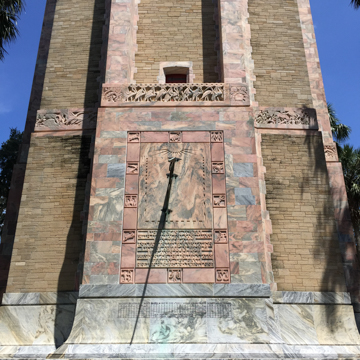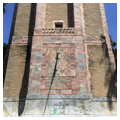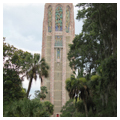Bok Tower Gardens was conceived as Mountain Lake Sanctuary and Singing Tower by publisher and author Edward W. Bok in 1922, and dedicated by President Calvin Coolidge on February 1, 1929. Frederick Law Olmsted Jr. laid out the 61-acre site, which encompassed a range of gardens and topographical conditions on Iron Mountain, the highest point in the peninsula of Florida (298 feet above sea level). Olmsted began his work in 1923. Three years later, architect Milton Bennett Medary designed the singing tower, which houses a 57-bell carillon. The tower features stylized Gothic massing and decoration and punctuates the landscape.
Bok had recently retired from his 30 years as editor of The Ladies’ Home Journal when he began planning the construction of a large nature preserve near his winter residence three miles north of Lake Wales. A native of the Netherlands who had immigrated to the United States as a child, Bok was active in numerous philanthropic causes related to arts, education, civic engagement, and peace studies. Bok was a prominent member of Philadelphia society, and the team that designed and built Bok Tower included a number of Philadelphians, including Medary.
Medary, who received the AIA Gold Medal the year Bok Tower was completed, designed the structure to resemble the medieval bell tower of St. Rumbold’s Cathedral in Mechelen, Belgium. Medary synthesized the campanile’s Gothic forms with the newly emerging Art Deco aesthetic of the Exposition Internationale des Arts Décoratifs et Industriels Modernes, which opened in Paris in 1925, the year before Bok commissioned Medary. The result is a more slender and streamlined building, which incorporates carved sculpture and other decorative arts.
The 205-foot-tall carillon tower is supported by a steel structural frame, which is clad in local coquina stone (quarried in Daytona Beach) and pink and gray marble from Georgia. The soft tones of the marble reflect the changing colors of the central Florida sun, producing ephemeral effects intended to complement the azaleas, camellias, and magnolias in Olmsted’s landscape. Medary collaborated with a number of artists, working in such media as sculpture, wrought-ironwork, brass repoussé, and ceramic faience. The marble sculpture was the work of Lee Lawrie, who would later produce much of sculptural reliefs and the enormous figure of Atlas at Rockefeller Center. Samuel Yellin produced the ironwork and brass entrance doors, while J. H. Dulles Allen of the Enfield Pottery and Tile Works created the polychromatic ceramic tile faience. Allen was another member of the team from Philadelphia, as was the building’s general contractor, Horace H. Burrell and Son.
While Olmsted envisioned the landscape as a great wildlife preserve, planted largely with native species, the site was originally a barren sand hill. Olmsted shaped the land, importing large amounts of rich soil, and laying irrigation lines throughout the gardens. The landscape incorporates expanses of live oaks, native pines, and saw palmettos, which act as a foil to the numerous flowering shrubs and trees, such as blueberries, gallberries, magnolia, gordonia, and Surinam cherries. The large number of fruit trees and shrubs reflects Medary’s insistence on plants that would act as habitat for migratory birds. When Bok decided to add the carillon tower several years after construction of the gardens had begun, Olmsted revised the landscape design to incorporate the landmark structure at the center of the composition. Visitors approaching the tower lose sight of it in the dense tree canopy, only to find it revealed suddenly.
Since its completion, Bok Tower Gardens has grown to 130 acres. The property, which is managed by Bok Tower Gardens Foundation, includes an adjoining estate, “El Retiro,” built in the early 1930s by C. Austin Buck and known today as Pinewood House and Garden. The tower now houses a library containing Bok’s writings and archival material related to the site’s history. Both the gardens and the tower are open to the public.
References
Bok, Edward W. The Americanization of Edward Bok: An Autobiography. 1924. Reprint, Philadelphia: American Foundation 1973.
Medary, Milton B. “The Bok Singing Tower.” ArchitectureLIX, no. 4 (April 1929): 199-202.
Schwarz, Rebecca Spain. “Bok Tower Gardens (Historic Bok Sanctuary),” Polk County, Florida. National Register of Historic Places Inventory–Nomination Form, 1992. National Park Service, U.S. Department of the Interior, Washington, D.C.



















